STUART ROY - NAVAL ARCHITECT
Fellow of the Royal Institution of Naval Architects & Chartered Engineer
Part 3: Construction: planking, frames, rowing deck and the coach
To assist with preparing the drawings for approval by Lloyds Register I invited Ed Burnett, a Totnes-based yacht designer and specialist in wooden yachts, who I knew from his university days, to join the team and design the wooden structure for Gloriana. It turned out that Ed is also a keen club rower, which made him the ideal choice, as he was also able to examine the geometry of the oars and rowing benches, tweaking the arrangement to make rowing such a large vessel as efficient as possible. Ed then proceeded to use his wide knowledge and experience of traditional craft to design an excellent arrangement blending conventional plank on frame construction with the use of modern epoxy glues and sealers to create a very strong integrated structure, which was relatively straightforward to build. During the autumn of 2011 he also gained the essential approvals from Lloyds Register by attending regular meetings with the surveyors from the Lloyds plan approval department, while supporting the structural design by reference to both historical published rules for wooden vessels and the more modern ISO 12215 standards. Throughout the plan approval process and the subsequent construction surveys the supportive approach from the technical team at Lloyds Register was of great assistance to the project.
Although the structural design, supporting documents and construction drawings were being progressed as rapidly as possible in Ed’s office, while I worked on developing the 3D stability model and addressed some of the other MCA Code compliance issues that would affect the design, the time left to build the boat was getting down to just a few months. It was clear that the project needed an experienced full-time project manager. Fortunately Ed was able to introduce us to Damian Byrne of Buckler’s Hard, who joined the project and managed the entire operation from October 2011 until completion in June 2012. The race was on.
With a large, empty factory unit on an industrial estate at Brentford secured for 6 months, Mark’s team of shipwrights moved in with their tools in November and were joined by a number of others who had just finished working on the restoration of the Cutty Sark, plus some young people from the Prince’s Trust. Quality was monitored by our own surveyor, Ron Heasell. The boat-building work was done in two shifts from early morning until late at night, seven days a week, with Mark supervising them for almost all of the time. As the boat was considered to be too large to turn over, it was built upright. Using iroko hardwood, the shipwrights first laminated together the timbers for a continuous 80ft keel and stem, and set up the keel on stools to put it at the right height. Then temporary moulds (section templates) for planking the hull were set up, and checked carefully. The hull planking was done in high-quality khaya plywood with epoxy-resin adhesives starting from the keel upwards, using 10 planks each side, overlapped at the edges in clinker fashion.
I visited the yard at the end of November 2011, not knowing what I would see. The doors of the main loading bay were open and as I walked up the concrete apron towards the building I saw this magnificent Viking Longship-inspired vessel with its knife-like bow and its wonderful-looking flare in the forward sections coming towards me diagonally across the vast factory floor. It was breathtaking and I knew instantly that it was going to look fabulous when afloat - it would definitely turn heads and get admiring glances. It was a magic moment - not only did it appear (at that stage) to be a beautiful re-born Viking Longship, but it looked even more impressive and attractive than it did on the computer screen several months earlier.
The planking took about a month before the temporary moulds could be removed in stages and replaced by 57 sawn frames and floors, also in iroko mahogany like the keel. The beams for the cabin or “coach” were being laminated over a jig at the same time, as Damian the project manager believes in opening a number of different work fronts to ensure good progress. The rowing benches and much of the interior of the cabin is made from sweet chestnut from Prince Charles’s estate. When the deck was in place and the coach well under way, the build team expanded rapidly so that groups of painters, engineering fitters and later artists could all be seen working on the boat. In all a total of 68 people were involved in the project.
While the wooden structure of the boat was being built at Brentford, some amazing pieces of ornamental sculpture were being created by the hugely-talented David Crosswell of Polygon Scenery in his workshop. Made in modern materials, they look absolutely fabulous when gilded but the weight of the long pieces at the cockpit did cause some concern to the design team, requiring the batteries to be installed further forward so that level trim would be maintained.
To comply with the MCA Code, the helmsman must be able to see the water at a point two ships lengths in front of the boat when viewed from or beside the steering position. Providing a suitable line of sight presents an interesting design challenge when there is a cabin in front of him complete with coats of arms and liferafts on top. Despite the elevated position of a rowbarge’s steering position, there was some concern over visibility for the helmsman. A practical test was therefore set up at the construction stage with a “buoy” positioned in the car park in front of the boatyard. Fortunately the Queen’s Bargemaster, Paul Ludwig, who had been advising Lord Sterling since the beginning of the project, was able to visit the yard and provide an authoritative opinion that the sight lines were indeed satisfactory.
Part 4 - Launching
To assist with preparing the drawings for approval by Lloyds Register I invited Ed Burnett, a Totnes-
Although the structural design, supporting documents and construction drawings were being progressed as rapidly as possible in Ed’s office, while I worked on developing the 3D stability model and addressed some of the other MCA Code compliance issues that would affect the design, the time left to build the boat was getting down to just a few months. It was clear that the project needed an experienced full-
With a large, empty factory unit on an industrial estate at Brentford secured for 6 months, Mark’s team of shipwrights moved in with their tools in November and were joined by a number of others who had just finished working on the restoration of the Cutty Sark, plus some young people from the Prince’s Trust. Quality was monitored by our own surveyor, Ron Heasell. The boat-
I visited the yard at the end of November 2011, not knowing what I would see. The doors of the main loading bay were open and as I walked up the concrete apron towards the building I saw this magnificent Viking Longship-
The planking took about a month before the temporary moulds could be removed in stages and replaced by 57 sawn frames and floors, also in iroko mahogany like the keel. The beams for the cabin or “coach” were being laminated over a jig at the same time, as Damian the project manager believes in opening a number of different work fronts to ensure good progress. The rowing benches and much of the interior of the cabin is made from sweet chestnut from Prince Charles’s estate. When the deck was in place and the coach well under way, the build team expanded rapidly so that groups of painters, engineering fitters and later artists could all be seen working on the boat. In all a total of 68 people were involved in the project.
While the wooden structure of the boat was being built at Brentford, some amazing pieces of ornamental sculpture were being created by the hugely-
To comply with the MCA Code, the helmsman must be able to see the water at a point two ships lengths in front of the boat when viewed from or beside the steering position. Providing a suitable line of sight presents an interesting design challenge when there is a cabin in front of him complete with coats of arms and liferafts on top. Despite the elevated position of a rowbarge’s steering position, there was some concern over visibility for the helmsman. A practical test was therefore set up at the construction stage with a “buoy” positioned in the car park in front of the boatyard. Fortunately the Queen’s Bargemaster, Paul Ludwig, who had been advising Lord Sterling since the beginning of the project, was able to visit the yard and provide an authoritative opinion that the sight lines were indeed satisfactory.
Part 4 -
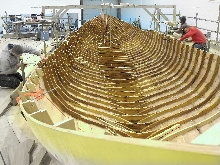
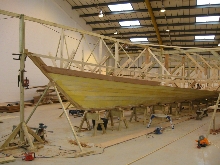
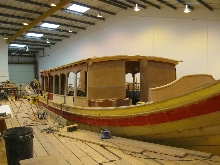
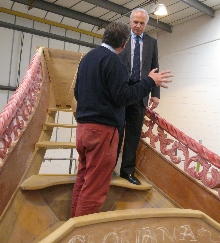
Hull Planking over temporary moulds
Fitting the 57 iroko mahogany frames
The “coach” starts to take shape
The Project Manager discusses the sight lines with the Queen’s Bargemaster
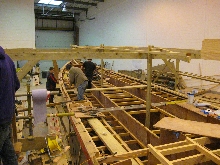
Building the rowing deck and footwells
Creating “Gloriana” - The Naval Architect’s story ………….
Index - click to activate link
Part 1 - Historial References
Part 2 - The design proposal
Part 3 - Construction
Part 4 - Launching
Part 5 - Trials & The Pageant
Larger Photographs
Part 2 -
Part 3 -
Part 4 -
Part 5 -
Larger Photographs